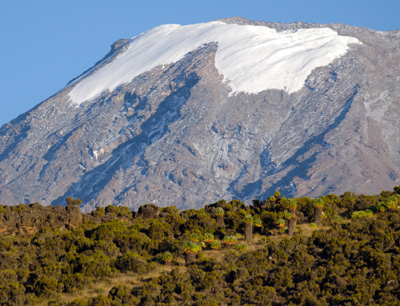Land-cover Changes Do not Impact Glacier Loss

The composition of land surface – such as vegetation type and land use – regulates the interaction of radiation, sensible heat and humidity between the land surface and the atmosphere and, thus, influences ground level climate directly. For the first time, the Innsbruck climate scientists quantitatively examined whether land-cover changes (LCC) may potentially affect glacier loss. “We used Kilimanjaro in East Africa as a test case, where a significant decrease of forests at elevations between 1,800 and 3,000 meters, caused by illegal deforestation and an increased number of forest fires, has been documented since the 1970s,“ explains climate researcher Thomas Mölg, who has worked in Berlin since 1 October 2011 but finished the study with his team at the University of Innsbruck. The glaciers in the Kilimanjaro area have been shrinking for many decades, and climate researchers from Innsbruck and America have conducted thorough glaciological and meteorological measurements for ten years –ideal prerequisites for carrying out a comprehensive study about a potential connection between forest loss and glacier shrinking.
Novel methodology
The prerequisite for conducting this study was a novel methodology that links a glacier and atmospheric model in such a way that no statistical corrections are necessary (published by Kaser/Mölg, 2011 in Journal of Geophysical Research). Direct measurements of various climate elements on Kilimanjaro such as temperature, humidity, radiation, precipitation and glacier mass changes showed that reality can be simulated well by this new methodology. “Based on this evaluation we then modified vegetation cover in the atmospheric model – first showing 1976 and subsequently the current state – and calculated its effect on glacier mass,” says Thomas Mölg.
The results show that LCC mainly alter precipitation over glaciers but with different effects on the Northern and Southern ice fields of the mountain (increase or decrease respectively), which results in local increase or decrease of glacier mass. “Depending on the season, LCC contributes not more than seven to 17 % to glacier mass loss in the southern sector. We, therefore, cannot confirm the hypothesis that deforestation at Kilimanjaro contributes significantly to glacier loss,“ explains Thomas Mölg.
Less precipitation in mid-mountain elevation zones
The results of the study suggest that relatively small-scale land-cover changes, such as on Kilimanjaro, may not have enough impact on the mountain climate to surpass the effects of global climate change on glaciers. “However, another important aspect of the results is that deforestation decreases precipitation significantly more in mid-mountain elevation zones about two kilometers below the glacier than in summit zones“. This affects local water reservoirs and reduces water supply for the local population.